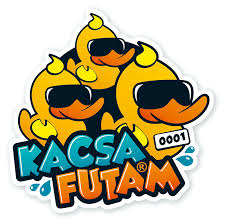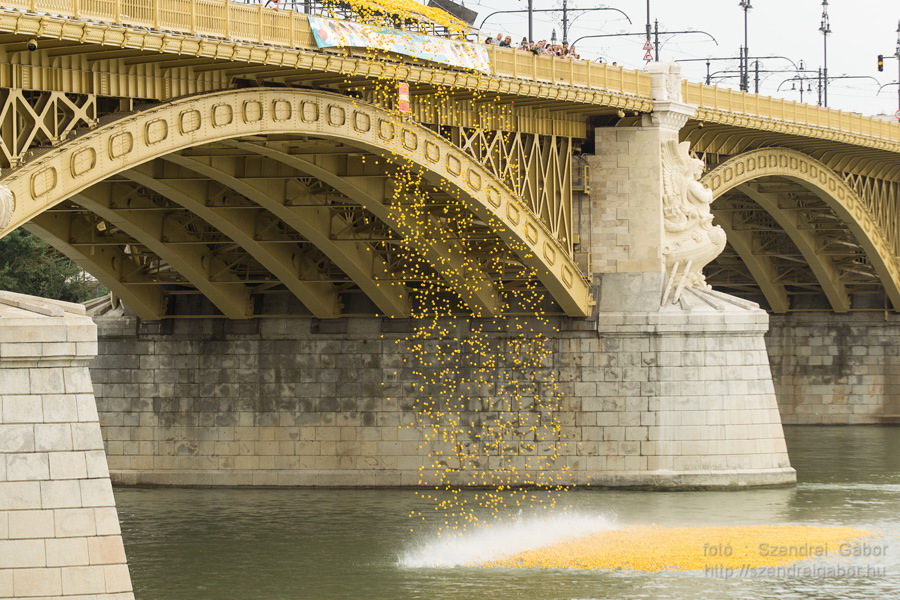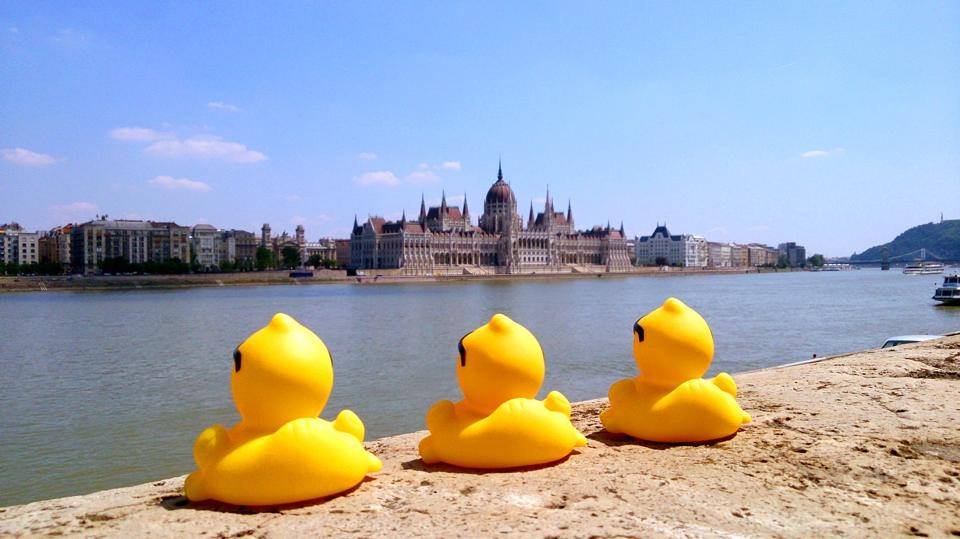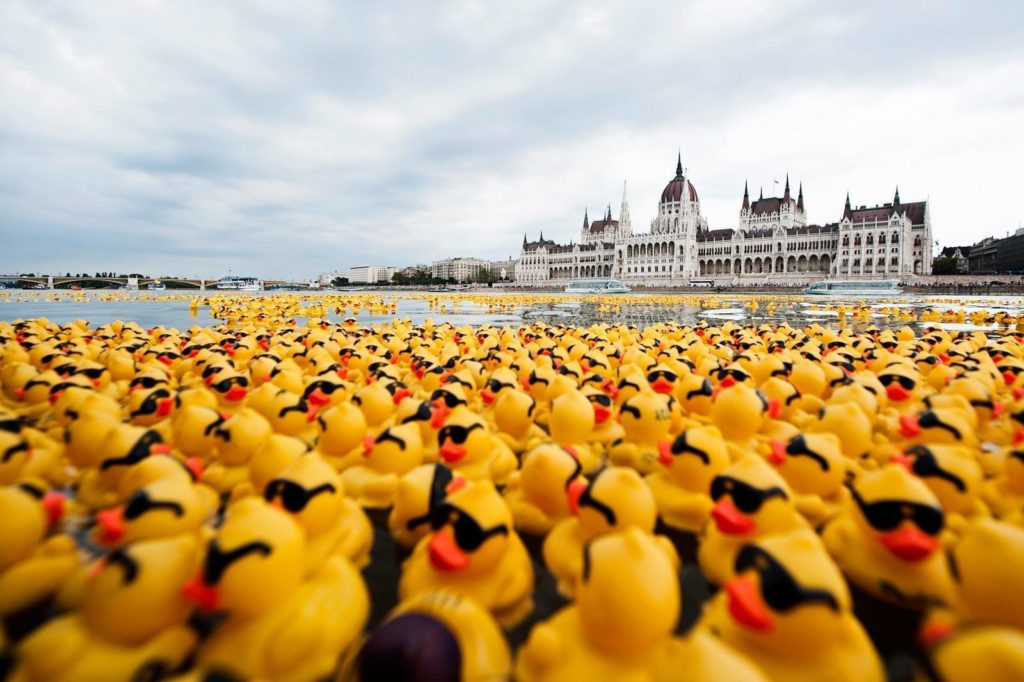
In 2015 and 2014, the Danube River became the stage for one of Budapest’s most unusual and endearing competitions: the Kacsafutam, or ‘duck race’. Thousands of little rubber ducks navigate its waters in an event that combines fun, community and solidarity. Although at first glance it may seem like a mere curiosity attraction, the Kacsafutam has a much deeper purpose: to raise funds for various charitable causes.
Origins and Global Context
The origins of the Kacsafutam in Budapest are inspired by a global trend that has captivated audiences around the world since the 1990s. Rubber duck races, where thousands of these toys float down the river, have become popular fundraising events in cities from Ohio and Colorado in the United States to Australia, the United Kingdom and Singapore. These events have proved hugely successful, attracting large crowds and generating significant sums of money for charities. The idea behind the Budapest Kacsafutam was not entirely original, but an adaptation of this proven international model, combining an entertaining spectacle with a noble cause. This connection to a global philanthropic tradition adds an extra appeal to the Hungarian event, showing that it is part of a worldwide movement of generosity and community involvement.
History of Kacsafutam in Budapest
2014

The debut of the Kacsafutam in Budapest took place on 31 August 2014. The inaugural route of this peculiar race stretched between Margaret Bridge and Batthyány Square, two iconic spots on the banks of the Danube. For this first event, approximately 52,000 rubber duckies were thrown into the river, creating an impressive visual spectacle that attracted the attention of the city. The charity that benefited from this first edition was UNICEF, the United Nations Children’s Fund. A highlight of the first race was the presence of a ‘Főkacsa’ (Chief Duck) who oversaw the event, adding a touch of humour and personality. Before the launch of the ducklings, Hungarian rowers paraded in dragon boats to promote the race, displaying duck-themed T-shirts. At around 2pm, the thousands of ducklings were released into the water, forming what was described as a ‘kacsafüggönyt’ (duck curtain) due to their sheer numbers. The ducklings floated down the Danube, jostling for position as they made their way to the finish line. The first 100 ducklings to cross the finish line, located after the Chain Bridge, awarded valuable prizes to their sponsors, whose winning numbers were published on the event’s website. The success of this first edition, with massive participation and the support of such a renowned organization as UNICEF, set a positive precedent for the future of Kacsafutam in Budapest.
2015

The second year, the Kacsafutam was held on 30 August 2015, consolidating the solidarity tradition in the Hungarian capital. This time, the race started from the Chain Bridge (Lánchíd), another iconic symbol of Budapest. The organisers were aiming for an even higher turnout, with the goal of reaching 100,000 ducklings competing on the Danube. In the end, more than 50,000 ducklings took part in the race. For the second year in a row, UNICEF was the charity to which the funds raised were donated. For the 2015 edition, UNICEF received 100 guilders for every duckling sold, a contribution that, as the organisation pointed out, could provide vital therapeutic food for a day or clean drinking water for 100 children in need. As in the first edition, owners of the first 100 ducklings to reach the finish line were rewarded with valuable prizes, including trips, electronic devices and gift vouchers. An additional attraction for the public was the live broadcast of the race on FM 91.4, allowing those who were unable to attend to witness the event. After the race, participants and spectators enjoyed surprise concerts in the ‘Öntöde’ part of the Várkert Bazár, extending the celebration beyond the aquatic competition itself. The continued collaboration with UNICEF and the increase in the number of participating ducklings demonstrated the growing support and popularity of Kacsafutam in Budapest.
Mechanics and Participation in the Event
The mechanics of Kacsafutam are simple and accessible, which contributes to its popularity. The event is based on the ‘adoption’ or sponsorship of rubber duckies by the public. In the 2014 and 2015 editions, the duckies were available for purchase at various outlets, including MOL petrol stations, Pirex shops, Régió toy shops, Relay and Inmedio kiosks, and the West End City Center shopping mall. Each ducky sold came with a unique numbered ticket that matched the number of the ducky, serving as proof of participation. In 2015, the price of each ducky was 999 guilders. For those who ordered online via REGIO JÁTÉK in 2014, a ‘control slip’ was sent to the customer, while the duck figure itself was delivered to the starting line. On the day of the race, thousands of rubber ducklings are launched into the Danube River from a specific starting point, which has varied between the Margaret Bridge and the Chain Bridge in different editions. The river current propels the ducklings along a predefined route to the finish line. The owners of the ducklings that cross the finish line in the first positions win various prizes. This sponsorship system allows a large number of people to contribute to the charitable cause in a fun and participatory way.



Comments are closed.